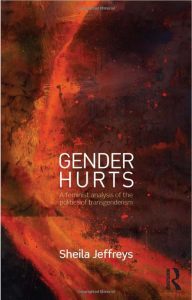A First Look at Sheila Jeffreys’ Gender Hurts
In 1979 feminist Janice G. Raymond published her magnum opus, The Transsexual Empire: The Making of the She-Male (read the 1994 edition here). It bore the same title and is essentially the same document as her 1977 doctoral dissertation at Boston College. Empire was published by Beacon Press and was reprinted in 1994 by Teachers College, Columbia University in New York and Editions du Seuil in Paris, with a new introduction.
 Raymond’s stated intent was to “morally mandate transsexualism out of existence,” and in Empire she attempted to build a rational case for doing just that. The result was a 185-page rant in which she posited the Thorazine-worthy notion that male-to-female transsexualism is a plot engineered by the male-dominated medical establishment to infiltrate the womens’ movement and ultimately “wrest from women the power inherent in female biology” and “make the biological woman obsolete by the creation of man-made ‘she-males’” (p. xvii).
Raymond’s stated intent was to “morally mandate transsexualism out of existence,” and in Empire she attempted to build a rational case for doing just that. The result was a 185-page rant in which she posited the Thorazine-worthy notion that male-to-female transsexualism is a plot engineered by the male-dominated medical establishment to infiltrate the womens’ movement and ultimately “wrest from women the power inherent in female biology” and “make the biological woman obsolete by the creation of man-made ‘she-males’” (p. xvii).
It doesn’t take long for Raymond’s lack of objectivity to show. In the first page of the Preface she writes of Renée Richards, “It takes castrated balls to play women’s tennis” (p. xiii). In later pages she directs personal attacks at male-to-female transsexuals Sandy Stone and Christy Barsky (pp. 101-103), and Jan Morris (pp. 86-90) (deliberately misgendering all three), coins the term male-to-constructed-female, and accuses all MTF and FTM transsexuals of raping women’s bodies. Seriously. She writes, “All transsexuals rape women’s bodies by reducing the real female form to an artifact, appropriating this body for themselves…” (p. 104). This while she is (yes, I’ll say it!) raping the minds of her readers.
At its best, Empire is an unhinged screed; at its worst, it reads like the scribblings of a paranoid schizophrenic — and yet despite its obvious bias, despite its mischaracterizations of transsexualism and transsexuals, and despite hundreds and perhaps thousands of denunciations and negative reviews, despite its having been called hate speech, it has been and remains an influential book in certain feminist circles.
Now, thirty-five years after the first publication of Empire, another separatist feminist has written a book about transsexualism. This time around the author is Australian Sheila Jeffreys and the book is Gender Hurts: A Feminist Analysis of the Politics of Transgenderism
I didn’t buy Gender Hurts. I will never buy a copy, for I am not interested in financing hatred. I was, however, willing to look it over to see if it had met my expectations, and so I was happy when Ken Dollarhide said he did not wish to keep his copy and asked if he might send it to me.
This is not a review of Jeffreys’ book. I have not yet read it, and perhaps I never well. This is, as the title implies, a first look. It’s my reaction to a quick scan of the work.
Nor is this the first time I’ve written about Gender Hurts. When I learned Jeffreys, whose dislike of transsexuals is manifest in her existing writing, was working on a book about trans issues which would be published by Routledge, I drafted a letter to the heads of both the publisher and its parent company, Taylor & Francis. Jamison Green agreed to co-sign.
In our letter, Jamison and I expressed our concern about Jeffrey’s forthcoming book and asked Routledge to ensure balance and respectful use of language. We received a prompt reply from Managing Director of Books Jeremy North of Routledge, assuring us Jeffreys had been properly vetted and Gender Hurts would be vigorously reviewed by her peers. He suggested we could review the book after it was published.
(My 2012 Letter (With Jamison Green) to Routledge Publishers)
And now I’m doing just that. Or, rather, I expect I will, if ever I can bring myself to read it. What follows is not a thorough review, but an impression based on a lookover of Gender Hurts.
Interestingly, the page count of Jeffreys’ book is almost the same as Raymond’s; at 189 pages it weighs in just four pages longer than Raymond’s 185.
 The first thing I saw when I opened Gender Hurts was a heading titled “The Efficacy of Sex Reassignment — Medical Disagreement.” The section led off with a discussion of the 1979 Archives of General PsychiatryGender Hurts — with an intent to stop transsexual surgery. It was a paper with findings that differed from other follow-up studies, and it was immediately and roundly criticized on methodological grounds (cf Fleming et al., 1980). Jeffrey chooses not to tell her readers about the controversy and instead implies Meyer & Reter was an early and groundbreaking study. That’s not true.
The first thing I saw when I opened Gender Hurts was a heading titled “The Efficacy of Sex Reassignment — Medical Disagreement.” The section led off with a discussion of the 1979 Archives of General PsychiatryGender Hurts — with an intent to stop transsexual surgery. It was a paper with findings that differed from other follow-up studies, and it was immediately and roundly criticized on methodological grounds (cf Fleming et al., 1980). Jeffrey chooses not to tell her readers about the controversy and instead implies Meyer & Reter was an early and groundbreaking study. That’s not true.
Two years earlier Stanley Biber had given a presentation about outcomes in 100 cases at the Fifth Interdisciplinary Symposium on Gender Dysphoria Syndrome. Two years before that Donald Laub had published a paper describing postsurgical outcome of 93 transsexual patients. Four years before that, John Money published a paper describing outcome of 24 cases. They, and dozens of other researchers, have found sex reassignment surgery to be remarkably effective — but again, Jeffreys’ readers would never know that.
Such selective quotation plagues Jeffreys’ book. Whenever possible she cites references which appear to support her point and avoids material which doesn’t. She even dredges up relatively rare voices of people who regret having had surgical sex reassignment, making it seem as if great hordes of us would choose not to do it had we the chance to revisit our decisions to transition and/or have surgery.
I didn’t continue reading because my eye was captured by the title of the next section: “Identifying ‘Real’ Transgenders.” Really, Sheila? Transgenders? Have you never heard of people-first language?
In the same section, Jeffreys misgenders Riki Anne Wilchins — which isn’t a big deal because Riki is known for misgendering herself. A quick flip through of the pages, however, revealed deliberate misgendering of both male-to-female and female-to-male transsexuals — a nasty and unnecessary trick. and one Jamison and I anticipated and asked Routledge to police. Clearly, they didn’t.
Similarly, Jeffreys uses quotation marks as bludgeons; for instance, a section on page 48 is titled “Transgender ‘Feminism”. This of course indicates to her readers that any feminism shown by transpeople is illegitimate and not comparable to the “real” feminism shown by “real” women.
Jeffreys most assuredly doesn’t like the idea of vaginas on people she considers men:
The newly carved-out orifices of male-bodied transgenders do not resemble vaginas; rather, they create new microbial habitats in which infections develop and cause serious smell issues for their owners. The problem of bad smell is a commonly occurring discussion thread on transgender advice websites. The medical evidence is that a bad smell exists and is associated with fecal bacteria common to those male-bodied transgenders who engage in “heterosexual” coitus. ‘Frequent episodes of malodorous discharge were reported by one in four women and malodour was even more frequently observed upon gynaecological examination, which in turn might relate to the presence of fecal bacterial vaginosis-like microflora’ (Weyers, et al., 2009). The neovaginas lack the lactobacilii connected with vaginal health in females. (pp. 70-71).
Weyers and his colleagues studied 50 postsurgical transsexual women and found microbial microflora that were simiilar to those of premenstrual girls: “Our study indicates that the microflora of the neovagina is characterized by bacterial species from the skin and the intestinal microflora, somewhat similar to what is observed with premenarchal girls…”
They also found microbial populations similar to those of women with vaginitis, and they noted an absense of lactobacilii (which is present in the vaginas of ovulating women, but not in girls) in all but one of their subjects.
What Jeffreys in arguing here is transsexual vaginas are not vaginas at all. And why is that? Because multivariate statistics found a significant difference between the microbes in vaginas of women born with them and those who acquired them later in life. In what world, I wonder, would one even begin to think there would not be differences in these two populations — and in what world would one consider the difference invalidating? In Sheila Jeffreys’ world, apparently.
Jeffreys takes great issue with treatment which accommodates the gender identities of trans children; in fact, in an attempt to link pubertal delay and transition to forced sterilization, she calls it eugenics — but she neglects to note the social engineers are not medical professionals, not parents, but trans children themselves. This is a point I made more than 15 years ago in a book chapter about Christine Jorgensen, and it holds for many trans children and teens: “It was the sheer force of her will which set the process in motion, persuading reluctant physicians to undertake such a novel set of treatments. Although she did not wield the lancet, Christine Jorgensen did her own sex change, moving into the female role with confidence and aplomb.”
I, like Christine Jorgensen and like many trans children, am my own eugenicist.
Jeffreys uses the word transgender in her title and throughout her book, but her primary target is transsexuals. Like Janice Raymond, she considers sex reassignment harmful to trans people, and, like Raymond, she blames transpeople for perpetuating the very same binary gender system our community is trying hard to destroy. Like Raymond, Jeffreys doesn’t seem to realize she plays her own part in continuing such norms by adopting a lesbian uniform that makes her look more than a bit like a man. She’s about four shots of testosterone away from passing as one. Somehow, though, it’s all our fault — and if we say it isn’t, we’re mistaken or lying. Moreover, we’re somehow suppressing her right to speak.
Jeffreys’ work, while essentially mirroring that of Raymond, doesn’t sound quite so bizarre. She is a far better writer than Raymond and as such might have written a far more insidious and dangerous book. I don’t know that. I have only skimmed the work. I can say, however, that having quickly looked over Jeffreys’ book, it is a nasty, one-sided political hack job.
My conclusion is that, like the Meyer & Reter study of 1979, Jeffreys’ positions in Gender Hurts were determined before the book was written. It’s what I expected, and it’s why Jamison and I wrote that letter to Routledge. We were prescient, and Routledge should be ashamed for allowing a hate-filled book to come to press.
Works Cited
Biber, S. (1977). Surgical experience and follow-up of 100 transsexual cases. In Proceedings of the Fifth Interdisciplinary Symposium on Gender Dysphoria Syndrome.Norfolk, VA: University of East Virginia Medical School.
Denny, Dallas. (1998). Black telephones, white refrigerators: Rethinking Christine Jorgensen. In D. Denny (Ed.), Current Concepts in Transgender Identity, pp. 35-44New York: Garland.
Fleming, M., Steinman, C., & Bocknek, G. (1980). Methodological problems in assessing sex-reassignment: A reply to Meyer and Reter. Archives of Sexual Behavior,9(5), 451-456.
Jeffreys, Sheila. (2014). Gender hurts: A feminist analysis of the politics of transgenderism. New York: Routledge.
Laub, Donald R. (1975). Follow-up on 93 patients undergoing rehabilitation and surgery. Conference Proceedings, Dept. Plastic and Rehabilitative Surgery, Stanford University.
Money, John. (1971). Prefatory remarks on outcome of sex reassignment in 24 cases of transsexualism. Archives of Sexual Behavior,1(2), 163-165.
Raymond, Janice. (1979). The Transsexual Empire: The making of the she-male. Boston: Beacon Press. Reprinted in 1994 by Teachers College, Columbia University, New York and Editions du Seuil, Paris.
Weyers, Steven, et al. (2009). Microflora of the penile skin-lined neovagina of transsexual women. BMC Microbiology, 9, 102. Read the paper here.
Category: Product Review, Transgender Body & Soul, Transgender Opinion




